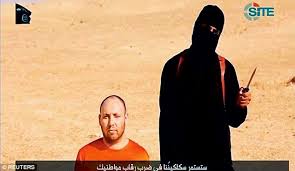
Graeme Wood’s lengthy article in the March Atlantic magazine, What ISIS Really Wants, is an insightful primer for Westerners that helps explain what the Islamic State of Iraq and al-Sham (ISIS) is, how it differs from al-Qaeda and other Islamic terrorist groups, and why the West and its leaders must understand its theology if it hopes to stop ISIS’s bloodthirsty rampage. It leaves the reader with the sense that ISIS is intent on a ‘holy war’ with the world whether the world wants one or not.
Contrary to President Obama’s puzzling assertion that ISIS is ‘not Islamic’, “the reality is that the Islamic State is Islamic. Very Islamic,” writes Wood. “The religion preached by its most ardent followers derives from coherent and even learned interpretations of Islam” … a distinctly medieval teaching of Islam with a “carefully considered commitment to returning civilization to a seventh-century legal environment, and ultimately to bring[ing] about the apocalypse.”
- To achieve its objectives, ISIS must control territory and establish a caliphate, which is simultaneously a political government and a vehicle for salvation. This has already happened. ISIS “seized Mosul, Iraq, last June, and already rules an area larger than the United Kingdom,” writes Wood. “Where it holds power, the state collects taxes, regulates prices, operates courts, and administers services ranging from health care and education to telecommunications.” (See Atlantic magazine’s map.) ISIS’s “social-welfare program is, at least in some aspects,” adds Wood, “progressive to a degree that would please an MSNBC pundit.”
- ISIS’s bloodbath — unrestrained executions, crucifixions, and beheadings — is a feature, not a bug. It seeks to purify the world by (a) killing vast numbers of non-believers and (b) purging the world of Muslim apostates, including Muslim heads of state who have put secular law about Sharia law by “running for office or enforcing laws not made by God.” ISIS’s medieval theology demands that it continue to “expand the caliphate” and “terrorize its enemies—a holy order to scare the shit out of them with beheadings and crucifixions and enslavement of women and children, because doing so hastens victory and avoids prolonged conflict.”
- ISIS is following a clearly defined Islamic ‘Prophetic methodology’. The capture of the Syrian city of Dabiq was an important step in that methodology. “Now that it has taken Dabiq, the Islamic State awaits the arrival of an enemy army there, whose defeat will initiate the countdown to the apocalpyse. … The Prophetic narration that foretells the Dabiq battle refers to the enemy as Rome. Who ‘Rome’ is, now that the pope has no army, remains a matter of debate. … Islamic State sources suggest that Rome might mean any infidel army…” After its victory at Dabiq, the prophesy goes, the caliphate will expand to cover the entire Earth, ushering in the end of time and the ultimate victory of Islam’s God.
The holy war ISIS currently pursues is as much against apostate Muslims as Westerners. ISIS’s leader, Abu Bakr al-Baghdadi “has said as much directly: in November he told his Saudi agents to “deal with the rafida [Shia] first … then al-Sulul [Suni supporters of the Saudi monarchy] … before the crusaders and their bases.”
The good news for the West is that ISIS is currently at odds with al-Qaeda, the Muslim Brotherhood, the Taliban and other Muslim groups.
ISIS demands of Muslims the total observance of, and submission to, the original medieval teaching of the Koran. In ISIS’s eyes, other Islamic groups have committed apostasy by adopting aspects of the modern world (e.g., the Muslim Brotherhood’s participation in elections in Egypt), by seeking worldly goals (e.g., al-Qaeda’s goal to expel non-Muslims from the Arabian peninsula, to abolish the state of Israel, to attack the United States), or by “innovations” to the Koran (e.g., the “roughly 200 million Shia [Muslims] are marked for death” because they have adopted “innovations” on the Koran’s teaching). Yet ISIS’s threat to the world could grow very rapidly if other Muslim groups and sects begin aligning with ISIS.
“The ideological purity of the Islamic State has one compensating virtue,” argues Wood; “it allows us to predict some of the group’s actions.”
Wood discusses the potential value of a full-scale military ground war to defeat ISIS at Dabiq. “Al-Qaeda is ineradicable because it can survive, cockroach-like, by going underground. The Islamic State cannot,” writes Wood. “If it loses its grip on its territory in Syria and Iraq, it will cease to be a caliphate.” If the caliphate goes away, so does ISIS’s emotional appeal and claim to doctrinal and intellectual superiority within the Muslim religion.
“And yet the risks of escalation are enormous,” writes Wood. “The biggest proponent of an American invasion is the Islamic State itself. … An invasion would be a huge propaganda victory for jihadists worldwide. … Given everything we know about the Islamic State, continuing to slowly bleed it, through air strikes and proxy warfare, appears the best of bad military options.”
However this unfolds, the world is in for a long bloody ride.
That the Islamic State holds the imminent fulfillment of prophecy as a matter of dogma at least tells us the mettle of our opponent. It is ready to cheer its own near-obliteration, and to remain confident, even when surrounded, that it will receive divine succor if it stays true to the prophetic model. Ideological tools may convince some potential converts that the group’s message is false, and military tools can limit its horrors. But for an organization as impervious to persuasion as the Islamic State, few measures short of these will matter, and the war may be a long one, even if it doesn’t last until the end of time.
What ISIS Really Wants, filled with insight from Wood’s personal interviews of Muslim scholars and imams, is worth reading in its entirely.


